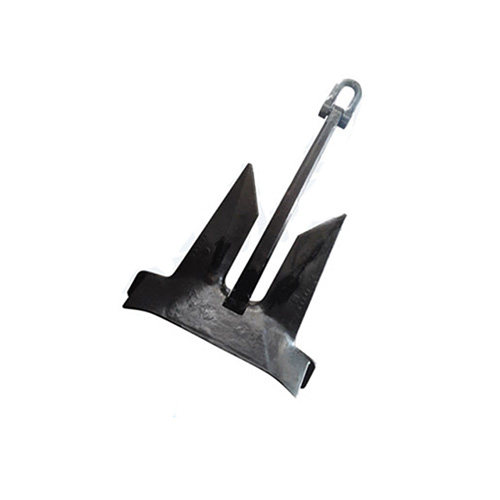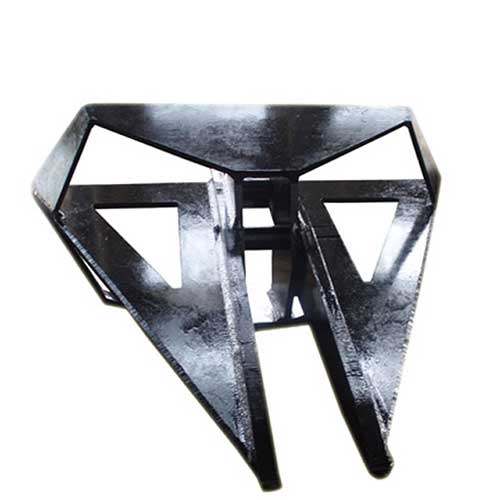High holding power anchors (HHP anchors) are specialized marine anchors designed to offer superior holding capability and stability in various seabed conditions. Their primary purpose is to securely anchor boats, buildings, or equipment to the seafloor, preventing drifting and unwanted movement. These anchors are specifically engineered to withstand the forces of wind, waves, and currents, providing reliable mooring even in challenging environmental conditions.

Key Components and Design Features of High Holding Power Anchors
Flukes or Blades: The flukes or blades of HHP anchors are designed to pierce the seafloor or substrate, maximizing holding capacity by generating resistance to pulling forces. The number, shape, and angle of the flukes may vary depending on the anchor's specific design.
Shank: The shank is the main structural component of the anchor, connecting the flukes to the anchor's connection point. It provides strength and rigidity, transmitting the load from the flukes to the anchor rode.
Stock: A crossbar or rod near the anchor's crown, the stock acts as a pivot point, allowing the anchor to position itself correctly on the seafloor. It aids in aligning the anchor with the force direction, ensuring efficient penetration and holding power.
Crown: Positioned at the top of the anchor, the crown connects the shank and the stock, equally distributing the load across the anchor and ensuring structural stability.
Weight Distribution: HHP anchors often have a balanced weight distribution, strategically dividing the weight across the flukes, shank, and crown to provide optimal penetration and maximum holding strength.
Surface Area: The flukes of HHP anchors usually have a wide surface area, increasing friction between the anchor and the seafloor and enhancing resistance to dragging forces.
Reinforcement and Material Selection: HHP anchors are constructed from strong and durable materials such as steel alloys, designed to withstand the immense loads and strains experienced during anchoring.
Roll Bar or Roll-Palm: Some HHP anchor types have a roll bar or roll-palm at the back to ensure proper alignment with the force direction, preventing the anchor from overturning during changes in wind or current direction.
Fluke Angle: The angle of the flukes relative to the shank influences the anchor's holding power. A larger fluke angle often improves the anchor's penetration and holding capabilities.
Retrieval Ability: HHP anchors are designed for easy retrieval, incorporating features like trip line attachment points or disassembly mechanisms for effortless removal from the seafloor.

Differences Between High Holding Power Anchors and Traditional Anchors
Design and Shape:
Traditional Anchors: These anchors typically feature a stock or shank attached to two or more curved or concave flukes or blades, relying on weight and fluke surface area for holding power. High Holding Power Anchors: HHP anchors have sharp, pointed flukes or blades that are longer and narrower, providing better penetration into the seabed and higher holding capacity.
Weight Distribution:
Traditional Anchors: Weight is more evenly distributed throughout the anchor's structure to achieve a balance of weight and surface area for holding force.
High Holding Power Anchors: HHP anchors concentrate more weight in the fluke or blade region, enhancing penetration and holding capacity in challenging seabed conditions. Holding Power and Performance:
Traditional Anchors: Traditional anchors work effectively in some seabed conditions but may have lower holding capability in challenging situations.
High Holding Power Anchors: HHP anchors are engineered to perform well in various seabed conditions, including soft sediments, clay, and rocky substrates, offering superior performance and dependability.
Applications and Industry Use:
Traditional Anchors: Used in leisure boating, small vessels, and inshore applications with lesser holding power requirements.
High Holding Power Anchors: Widely used in offshore industries, including offshore oil and gas platforms, floating production systems, large commercial vessels, and floating wind turbines, due to their increased holding capacity and reliability in harsh marine environments.

Factors Influencing the Selection of High Holding Power Anchors
To ensure optimal performance and safety, several factors must be considered when selecting high holding power anchors:
Vessel Size and Type: The size and type of the vessel influence anchor selection, with larger vessels requiring anchors with higher holding capacity to withstand additional loads.
Holding Power Requirements: Consider water depth, seabed type, wind and current conditions, and predicted loads to determine the anchor's necessary holding force.
Anchor Weight and Size: Choose an anchor that is appropriate for the vessel, striking a balance between weight and holding power.
Anchor Type: Different anchor types are suited for various seabed conditions, so consider factors like holding power, penetration ability, and ease of usage when making a selection.
Construction Material: Opt for materials like steel or alloys that are corrosion-resistant and durable.
Ease of Deployment and Retrieval: Consider anchor design, weight, handling methods, and compatibility with the vessel's anchoring system for easy deployment and retrieval.
Reputation and Reviews: Research the reputation and reviews of various anchor brands and models to gauge their performance, reliability, and durability.
Budget: Consider the cost of the anchor while prioritizing quality and performance.
Legal and Regulatory Requirements: Check for any legal or regulatory requirements that specify the type and size of anchors allowed in the region or canal.
Summary
High holding power anchors play a crucial role in ensuring stability, safety, and efficiency in maritime and offshore operations by securely anchoring vessels and structures. With their optimized design, weight distribution, and ability to thrive in various seabed conditions, HHP anchors have become the preferred choice for critical mooring operations in offshore settings. Careful consideration of factors such as vessel size, holding power requirements, anchor type, and construction material will result in the selection of an anchor that meets the specific needs of the operation, enhancing safety and performance.

